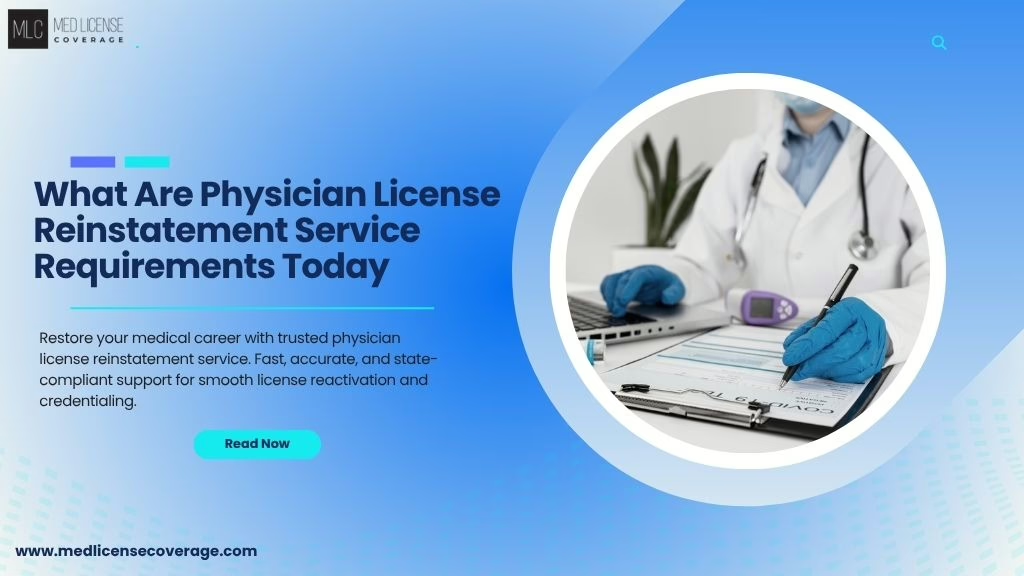Restoring a physician license requires meeting several requirements set by the state board. The process for reinstating a physician license is necessary when a certificate ends up being non-active, put on hold, or withdrawn. The process ensures that only certified professionals can resume their medical practice. Every state has its structure; however, many comply with similar guidelines.
Reasons Physician License Reinstatement ServiceIs Essential
There are several situations where doctors require reinstatement:
- Missed License renewal due dates
- Disciplinary action on the board
- Volunteer retirement or professional time out
- Transitioning between states
- Keeping up with Continuing Medical Education (CME) is another challenge.
In all these situations, medical professionals are not allowed to provide care up until their license is renewed. Therefore, finding a solution to reinstate a doctor’s license is crucial for regaining active status.
Key Elements of the Reinstatement Process
Reinstatement of a license is manual. It consists of
- The process begins with the submission of an application for reinstatement.
- The process also includes the repayment of reinstatement charges.
- The application must include proof of completion of CME.
- The practice history must be documented.
- Disciplinary documents are entered.
- Criminal background check
These actions are developed to confirm the medical professional’s existing competence. Each action contributes to maintaining the integrity of client treatment nationwide.
Function of Medical Licensing Solutions
Medical licensing services supply expert support in navigating state-specific reinstatement standards. Their major contributions include:
- The services they provide include organizing the necessary records.
- They ensure that their education and experience are validated.
- It is crucial to submit forms on time.
- We also monitor our progress with the state board.
These solutions lower hold-ups and mistakes. The Physician License Reinstatement Service is more efficient when supported by specialists who comprehend licensing protocols.
State-Specific Guidelines for Reinstatement
Reinstatement varies depending on the place. Below are a couple of examples:
- Texas: Calls for a passing score on the jurisprudence examination and CME hours within 24 months.
- Michigan: Needs fingerprinting and upgraded CME proof.
- New Jersey: May include interviews and work history evaluation.
- North Carolina requires the submission of all necessary paperwork related to any area of practice.
- Pennsylvania: Demands legal documentation if the certificate was withdrawn.
Each state needs to verify that returning professionals meet their standards for secure practices. Hospital credentialing by the state also depends on the credibility of this reinstatement.
Common Obstacles in Reinstatement.
A number of issues might postpone or reject reinstatement:
- The reinstatement may be delayed or rejected due to unpaid Missing CME credits.
- Incomplete work documents may also cause delays.
- The corrective actions have not been adequately addressed.
- There are still unresolved legal matters to be addressed.
- There are gaps in medical technique that need to be explained.
Using a medical professional license reinstatement service can help you deal with these obstacles successfully. Professionals in the field provide solutions that meet state regulations and prevent the rejection of applications.
Relevance of CME in Reinstatement
CME is a needed element in most reinstatement applications. Programs usually include:
- Medical principles.
- Individual safety.
- Medical updates.
- Professional growth.
This demonstrates upgraded understanding and preparedness to go back to practice. Many states require at least 50 CME hours completed within the last two years. Missing or dated CME documents frequently cause delays.
Confirming Credentials for Healthcare Facility Techniques
When reinstatement is accepted, physicians are also required to undertake health center credentialing. This process verifies:
- The process verifies the credibility of the restored license.
- CME documentation.
- Records of insurance coverage and obligations are also required.
- You must also have a history of previous work and malpractice.
Without healthcare facility credentialing by the state, doctors may not be authorized to operate in clinics, hospitals, or healthcare networks. Reinstatement alone does not approve healthcare facility access. Medical licensing solutions play a twin function in helping with both reinstatement and credentialing.
How Background Checks Influence Reinstatement
A background check is a mandatory part of most reinstatement applications. It consists of:
- Medical background.
- prior disciplinary actions in prior disciplinary actions.
- There could be instances of substance abuse or professional misconduct.
Any kind of red flag requires description and resolution. Boards examine the ethical and professional condition of the physician before approving a brand-new certificate. Clear documents sustain quicker approvals.
Benefits of Employing a Reinstatement Service
A specialized medical professional certificate reinstatement service supplies several benefits:
- Accurate conclusion of files.
- Faster interaction with state boards.
- Timely updates on application standing.
- Support during meetings or hearings.
- Assist with credential verification.
This strategy guarantees fewer hold-ups and improves the chances of reinstatement. For doctors handling several licenses or dealing with difficult records, expert services can be essential.
License renewal After Reinstatement
After reinstatement, medical professionals should comply with regular renewal cycles. Each state describes
- Expiration dates.
- CME needs.
- Renewal charges.
Missing renewals may result in having to duplicate the reinstatement procedure. Remaining certified after reinstatement avoids future interruptions.
Reinstatement for Telemedicine Technique
Growth of telemedicine has actually raised the demand for restored licenses. Physicians exercising across numerous states must:
- Hold active licenses in all territories.
- Comply with guidelines under the Interstate Medical Licensure Compact (IMLC).
- Guarantee conformity with telehealth credentialing.
Reinstatement sustains secure, cross-border electronic treatment. States prioritize individual safety and security in telemedicine similarly to in-person treatment.
Restoring Licenses After Retirement
- Retired physicians typically seek reinstatement because of:
- Medical professionals lack.
- They have an interest in volunteering their time.
- Returning to Medical practice is essential.
They must meet the same requirements as energetic professionals. Additional analyses might consist of wellness testing and skill assessments.
Conclusion
The Physician License Reinstatement Service is necessary for going back to the medical method. It ensures that medical professionals satisfy current educational, ethical, and scientific criteria. Every step—application, documentation, CME, and background check—plays a role in public health safety. Utilizing professional Medical licensing services improves the precision and speed of this process. From reinstatement to health center credentialing by state, each step maintains top-quality medical care and conformity.
FAQs
1. What Circumstances Require Reinstatement of a Physician’s License?
Reinstatement reporting is necessary when a physician’s license becomes inactive due to failure to renew, the circumstances require ‘re-education’ due to a sanction or retirement, or when a ‘gap in practice’ is acceptable in transitioning between states. In any case, restitution is essential before a physician re-enters practice to protect society from unqualified professionals.
2. What Documents Are Needed for Reinstatement?
The most important documents for reinstatement are proof of completion of CME, follow-up services, practice history, disciplinary records or notices, a criminal background check, and the application for reinstatement. Each state has its own statutory regulations and professional standards and may require additional requirements for reinstatement.
3. How Does Maintaining Cme Affect Reinstatement?
In a reinstatement process, CME is crucial, as it shows the physician’s current medical knowledge. Most states require at least 50 hours of CME completed in the last two years. If the physician’s CME credits cannot be verified, or they are old, it could delay or impede the reinstatement application from being approved.
4. What Obstacles Can Postpone Reinstatement?
Delays can accrue for a multitude of reasons, such as missing CME, unfinished work history, unresolved disciplinary issues, or legal issues. If there are gaps in medical practice, they must be explained to protect the reinstatement application from being denied or prolonged in processing.
5. How Do Reinstatement Services Assist a Physician?
Reinstatement services can alleviate the paperwork, ensure submission timelines are met, help with credential verification, and communicate with various boards. It can alleviate the timeline delays, eliminate errors, and improve the odds of getting a license approval, along with success in the credentialing with hospitals.
6. Is Reinstatement Necessary If the Physician Does Telemedicine?
Yes, reinstatement is necessary if the physician only practices telemedicine. The physician must hold an active license in every state where their patients reside, and the physician must comply with the Interstate Medical Licensure Compact (IMLC) and telehealth credentialing.
Summary
Reinstating a physician license requires an application, fees, CME, and background checks and varies from state to state. Reinstatement services help with submissions, timelines, and re-subs. After reinstatement, credentialing occurs. Services help with errors, approvals, and assisting physicians returning to practice after suspension, retirement, or lapsed certification.







